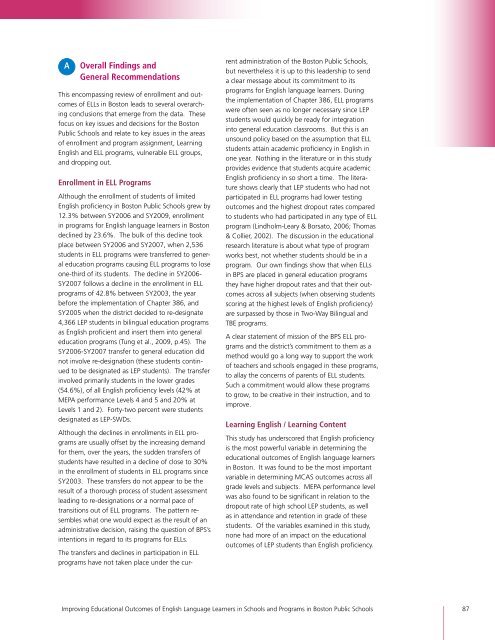Full Report - Center for Collaborative Education
Full Report - Center for Collaborative Education
Full Report - Center for Collaborative Education
You also want an ePaper? Increase the reach of your titles
YUMPU automatically turns print PDFs into web optimized ePapers that Google loves.
A Overall Findings and<br />
General Recommendations<br />
This encompassing review of enrollment and outcomes<br />
of ELLs in Boston leads to several overarching<br />
conclusions that emerge from the data. These<br />
focus on key issues and decisions <strong>for</strong> the Boston<br />
Public Schools and relate to key issues in the areas<br />
of enrollment and program assignment, Learning<br />
English and ELL programs, vulnerable ELL groups,<br />
and dropping out.<br />
Enrollment in ELL Programs<br />
Although the enrollment of students of limited<br />
English proficiency in Boston Public Schools grew by<br />
12.3% between SY2006 and SY2009, enrollment<br />
in programs <strong>for</strong> English language learners in Boston<br />
declined by 23.6%. The bulk of this decline took<br />
place between SY2006 and SY2007, when 2,536<br />
students in ELL programs were transferred to general<br />
education programs causing ELL programs to lose<br />
one-third of its students. The decline in SY2006-<br />
SY2007 follows a decline in the enrollment in ELL<br />
programs of 42.8% between SY2003, the year<br />
be<strong>for</strong>e the implementation of Chapter 386, and<br />
SY2005 when the district decided to re-designate<br />
4,366 LEP students in bilingual education programs<br />
as English proficient and insert them into general<br />
education programs (Tung et al., 2009, p.45). The<br />
SY2006-SY2007 transfer to general education did<br />
not involve re-designation (these students continued<br />
to be designated as LEP students). The transfer<br />
involved primarily students in the lower grades<br />
(54.6%), of all English proficiency levels (42% at<br />
MEPA per<strong>for</strong>mance Levels 4 and 5 and 20% at<br />
Levels 1 and 2). Forty-two percent were students<br />
designated as LEP-SWDs.<br />
Although the declines in enrollments in ELL programs<br />
are usually offset by the increasing demand<br />
<strong>for</strong> them, over the years, the sudden transfers of<br />
students have resulted in a decline of close to 30%<br />
in the enrollment of students in ELL programs since<br />
SY2003. These transfers do not appear to be the<br />
result of a thorough process of student assessment<br />
leading to re-designations or a normal pace of<br />
transitions out of ELL programs. The pattern resembles<br />
what one would expect as the result of an<br />
administrative decision, raising the question of BPS’s<br />
intentions in regard to its programs <strong>for</strong> ELLs.<br />
The transfers and declines in participation in ELL<br />
programs have not taken place under the cur-<br />
rent administration of the Boston Public Schools,<br />
but nevertheless it is up to this leadership to send<br />
a clear message about its commitment to its<br />
programs <strong>for</strong> English language learners. During<br />
the implementation of Chapter 386, ELL programs<br />
were often seen as no longer necessary since LEP<br />
students would quickly be ready <strong>for</strong> integration<br />
into general education classrooms. But this is an<br />
unsound policy based on the assumption that ELL<br />
students attain academic proficiency in English in<br />
one year. Nothing in the literature or in this study<br />
provides evidence that students acquire academic<br />
English proficiency in so short a time. The literature<br />
shows clearly that LEP students who had not<br />
participated in ELL programs had lower testing<br />
outcomes and the highest dropout rates compared<br />
to students who had participated in any type of ELL<br />
program (Lindholm-Leary & Borsato, 2006; Thomas<br />
& Collier, 2002). The discussion in the educational<br />
research literature is about what type of program<br />
works best, not whether students should be in a<br />
program. Our own findings show that when ELLs<br />
in BPS are placed in general education programs<br />
they have higher dropout rates and that their outcomes<br />
across all subjects (when observing students<br />
scoring at the highest levels of English proficiency)<br />
are surpassed by those in Two-Way Bilingual and<br />
TBE programs.<br />
A clear statement of mission of the BPS ELL programs<br />
and the district’s commitment to them as a<br />
method would go a long way to support the work<br />
of teachers and schools engaged in these programs,<br />
to allay the concerns of parents of ELL students.<br />
Such a commitment would allow these programs<br />
to grow, to be creative in their instruction, and to<br />
improve.<br />
Learning English / Learning Content<br />
This study has underscored that English proficiency<br />
is the most powerful variable in determining the<br />
educational outcomes of English language learners<br />
in Boston. It was found to be the most important<br />
variable in determining MCAS outcomes across all<br />
grade levels and subjects. MEPA per<strong>for</strong>mance level<br />
was also found to be significant in relation to the<br />
dropout rate of high school LEP students, as well<br />
as in attendance and retention in grade of these<br />
students. Of the variables examined in this study,<br />
none had more of an impact on the educational<br />
outcomes of LEP students than English proficiency.<br />
Improving <strong>Education</strong>al Outcomes of English Language Learners in Schools and Programs in Boston Public Schools 87


